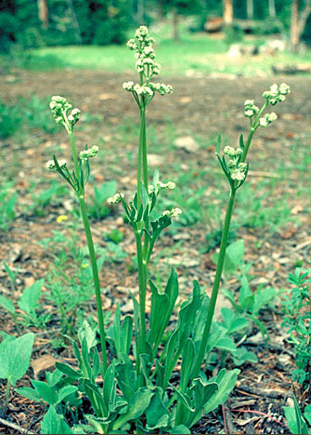One of the roots obtained by George Drouillard on 21 August 1805 may have been a species of valerian (vuh-LEHR-ee-an), such as Valeriana edulis (vuh-leh-ree-AYE-nuh ed-YOU-lis), or edible valerian. Lewis described it as being:
fusiform abot six inches long and about the size of a man’s finger at the larger end tapering into a small point. the radicles [secondary roots, rootlets] larger than in most fusiform roots. the rind was white and thin. the body or consistence of the root was white mealy and easily reduced by pounding to a substance resembleing flour which thickens with boiling water something like flour and is agreeably flavored. this rout is frequently eaten by the Indians either green or in it’s dryed state without the preparation of boiling.
Fusiform means spindle-shaped, that is, tapered at both ends, so Lewis misspoke. His description was correct, however. Valeriana edulis does have a carrot-shaped root.
The botanical Latin name–a form of the word valere, “to be healthy”–refers to its once widely recognized medicinal qualities. Indians used it chiefly as a topical for boils, bruises, rheumatism, and bleeding wounds. The root is poisonous if eaten raw, but if properly cooked it is safe and tasty. Many tribes, including the Lemhi Shoshones, consumed great quantities of it, partly because it is large and relatively easy to harvest, and also because it is quite nutritious. It has been said to taste like chewing tobacco, which accounts for another of its common names, tobacco root, although it has never gained any popularity among nicotine addicts. For centuries, the roots of some species of the genus Valeriana have been used as tranquilizers.
About a dozen of the world’s 200 species of the genus Valeriana are found in the Northern Rockies. In September the roots emit a strong odor which some say resembles the stench of unwashed feet, almost sickeningly so, but no one will deny it seizes one’s attention. In any case, it foretells the onset of autumn in the Rockies. The men may have noticed it as they crossed the Bitterroot Range west of Travelers’ Rest in September 1805, and wondered where the stink was coming from, but none of the journalists pointed their fingers at anyone else. On their way back across the Bitterroots in late June 1806 they would have seen it in leaf, though not yet in bloom, and far from odiferous. Although Lewis collected more than fifty plant specimens along the Lolo Trail, he apparently did not pay particular attention to any species of the ubiquitous, mostly inconspicuous—but seasonally obnoxious—Valeriana.
Experience the Lewis and Clark Trail
The Lewis and Clark Trail Experience—our sister site at lewisandclark.travel—connects the world to people and places on the Lewis and Clark Trail.
Discover More
- The Lewis and Clark Expedition: Day by Day by Gary E. Moulton (University of Nebraska Press, 2018). The story in prose, 14 May 1804–23 September 1806.
- The Lewis and Clark Journals: An American Epic of Discovery (abridged) by Gary E. Moulton (University of Nebraska Press, 2003). Selected journal excerpts, 14 May 1804–23 September 1806.
- The Lewis and Clark Journals. by Gary E. Moulton (University of Nebraska Press, 1983–2001). The complete story in 13 volumes.


